On the weekend of August 22-24, 2015, I had a chance to remedy this situation during a visit to one of my favourite spots, the cottage of our friends Robert and Norma Terro on Basshaunt Lake near Haliburton, when darners proved to be not only common but cooperative.
Our chief purpose - besides a welcome getaway - was to drop our grandson Ryan off for a week at camp and to give Ryder and Royce, his eager younger brothers, a taste of cottage life.
I took every opportunity, though, to shoulder my monopod and set off in pursuit of dragonflies (and anything else that happened by). There were, of course, still libellulids about for me to photograph, including this fine male Slaty Skimmer (Libellula incesta).
Meadowhawks (Sympetrum spp) tend to fly later in the season than other libellulids, and there were still plenty of them about. This one is a male White-faced Meadowhawk (Sympetrum obtrusum).
This is apparently a female White-faced Meadowhawk, though I at first took it for a related species, the Cherry-faced Meadowhawk (Sympetrum internum).
The Black-shouldered Spinyleg (Dromogomphus spinosus) was the only member of the third common dragonfly family in the area, the Gomphidae, still flying this late in the season. Their absence, and that of most of the libellulids, left the field open to the Aeshnidae, and particularly to the so-called ‘mosaic’ darners in the genus Aeshna.
My walks along the dirt road in front of the cottage turned up numbers of them, not only on the wing in search of late-summer insects but, more frequently than I had seen before, perched on tree trunks, limbs and grass stems. Many of our darners are quite similar to each other and identifying them on the wing can be difficult if not impossible, but judging by perched individuals the most numerous species appeared to be the Black-tipped Darner (Aeshna tuberculifera). Notice that the two stripes on the side of the thorax are broad and straight, one of the identifying marks of this species.
A lot of dragonfly and damselfly identification requires you to pay attention to the genital appendages at the tip of the abdomen. While most libellulid dragonflies are content simply to drop their eggs into the water, usually while in flight (exophytic oviposition, if you want the technical term), female darners, like female damselflies, lay their eggs within the tissues of living or rotten plants (endophytic oviposition). To accomplish this, they bore into plant stems with an ovipositor equipped with cutting blades. These are not the long, petal-like structures you can see here, which are properly termed the cerci; the ovipositor, or what you can see of it, is the little thorn-like structure sticking out to the right. Anyway, the key feature that marks this as a Black-tipped Darner is the lack of any blue markings on the tenth, or last, abdominal segment.
Notice that on this Darner the first of the two broad stripes on the side of the thorax has a distinct kink, and that the tenth abdominal segment is marked with blue. That makes this a Canada Darner (Aeshna canadensis), a species with a wide North American range.
My third mosaic Darner was the Variable, the species at the top of this post. This is a northern dragonfly, with the main part of its range centred on the US-Canada border. This one is a female, perched (uncharacteristically) horizontally.
I subsequently found another Variable Darner clinging to a dry stalk close to the ground. Notice that one of its cerci has been broken off - something that, apparently, happens frequently to darners.
This is the most distinctive of the three mosaic darners I found on this trip. The ground colour of the Variable Darner is chocolate brown rather than blackish, and the thoracic stripes are broken in the middle into two sets of teardrop-shaped markings. Not all Variable Darners have broken thoracic stripes (hence the name ‘Variable’), but the ones that do are easy to identify. Notice the ovipositor in the upper photo. This, too, is a female despite its male-like (or andromorph) colouration.
My fourth darner species was not one of the mosaic darners, but a female Common Green Darner (Anax junius). Is the fact that the perched darners I saw seemed to be mostly, or all, female a coincidence, or does it reflect a genuine behavioural difference between the sexes? It seems unlikely that the insects in my photos are looking for oviposition sites, because darner eggs still have to be deposited in or near water. Are they simply saving energy, while the males do the work of locating a potential mate?
In the end, despite the rush of aeshnids in late summer, it is the libellulids that hold the sky the longest (though the Common Green Darner, our most notable dragonfly migrant, is on the wing somewhere throughout the year and is usually the first one to turn up in spring). Migrants aside, the last adult dragonfly of each Ontario year is probably an Autumn Meadowhawk (Sympetrum vicinum). Autumn Meadowhawks may be on the wing as late as November. They emerge in August, when they can be told from similar meadohawks by their pale rather than black legs (the legs darken with age), and by the relatively reduced amount of black on the sides of the abdomen.
As excited as I was by the relative flood of darners, I managed to keep my eyes open for other things. Cottages in the area take pride in their flower gardens, and the Michigan Lilies (Lilium michiganense) I admired along the roadside, though native, may well have been garden escapees.
The same may be true for Oswego-tea (Monarda didyma), a member of the mint family, so called because it was used as an herbal medicine by the Oswego tribe and because it served as a tea substitute for early settlers (especially after the Boston Tea Party, when tea from Britain became hard to come by). It has a number of other common names, including bee-balm and bergamot.
Strawberry-Blite (Chenopodium capitatum), besides being unusual and attractive (this is another native plant frequently planted in gardens), can be used as a spinach substitute. Spotted Touch-me-not or Orange Jewelweed (Impatiens capensis) is another attractive native flower. It, too, has medicinal uses (it can counteract the effects of poison ivy, for example), can be eaten (if boiled thoroughly to remove toxins) and provides an essential oil that can be used to make soap.
Canada Goldenrod (Solidago canadensis) is one of the commonest roadside flowers in late summer (and is regularly blamed, falsely, for outbreaks of hay fever). Besides being attractive to (most?) humans, it is extremely popular with a variety of pollinating insects.
Among them is he Tricoloured or Orange-belted Bumble Bee (Bombus ternarius), a widespread North American insect best distinguished by the broad orange band on its abdomen. It is supposed to be particularly partial to goldenrod, and certainly there were lots of them swarming over the yellow flowers. Interestingly, before Honey Bees (Apis mellifera) were introduced to North America this was the only bee on the continent that could produce honey.
Slugs are less interested in pollinating goldenrods than they are in eating them.
Slugs are eaten in their turn by, along other things, predatory insects. This one appears to have fallen victim, as far as I can tell, to a Giant Water Bug (Lethocerus americanus).
The Great Black Wasp (Sphex pensylvanicus) is, interestingly, the first insect in North America to have been the subject of a scientific report (to the Royal Society, in 1749). Adults are important pollinators of a number of plants, but like all digger wasps these are hunting insects. Their larvae feed not on nectar, but on the living bodies of insects and spiders paralyzed by their parents' sting and dragged to their underground nests to be devoured.
Many species of hoverfly (Syrphidae) are confirmed nectar-feeders, and a number look remarkably like bees. They do not sting, but their potential predators aren't supposed to know that.
Sometimes the temptation to photograph a plant is matched by the temptation to eat it, or at least its fruit. That is especially true of Wild Blackberries (Rubus sp.), and I can report that these were very good indeed.
Stiff clubmoss (Lycopodium annotinum) may lack flowers or fruit, but I find them fascinating, if only because of their great geological age. Giant clubmosses were the trees of the Carboniferous coal forests, long before conifers and flowering plants first appeared.
Fungi are probably even older; tree-sized fungi may have risen on land even before the days of the coal forests. Fungi, though, are not plants but members of their own kingdom, and are probably more closely related to animals (including ourselves) than they are to clubmosses and goldenrods.I am even worse at identifying fungi than I am at naming plants, but I believe this to be Beefsteak Fungus (Fistulina hepatica). Its name comes from its appearance, not its flavour.
This post has, so far, ignored vertebrates (my grandchildren excepted). To make up for it, here are a couple of Green Frogs (Lithobates clamitans), the most obvious amphibians around Basshaunt Lake.
Here, too, are a few of the birds I found on my walks. Black-capped Chickadees (Poecile atricapilla) are noisy, ubiquitous and bold, and are probably the most obvious woodland bird (at least outside of the migration season).
The Red-breasted Nuthatch (Sitta canadensis), the smaller of Ontario's two nuthatches, is one of the most delightful birds we have. I apologize for not having better photos of it. I cannot see this bird without thinking of my old friend and talented nature artist Barry Kent Mackay, who in his bird rehabilitation days many years ago once cared for a Red-breasted Nuthatch named Sitta. Sitta develped a particular attachment to Barry's late mother Phyllis, and entertained us all by turning an almost endless series of rapidly-executed backflips (accomplished by leaping from her perch to the top of her cage and hanging briefly upside down from the bars before returning to her perch to start over).
The Chipping Sparrow (Spizella passerina) may well be our commonest American sparrow. For my Old World readers, American sparrows are not related to the "true" sparrows (Passeridae), but are part of the great Norh American radiaton of 'nine-primaried' oscines that includes tanagers, America orioles and blackbirds, wood warblers, cardinals and a host of others including the Old World buntings. Their classification has been, to put it mildly, in a state of flux in recent years, with the most recent (?) change being the creation of a new bird family for the American sparrows alone. Unfortunately ornithologists don't seem to agree on what to call it. The American Ornithologists' Union, however, recently settled (?) the matter by agreeing on the name Passerellidae, tossing an older name that would otherwise have had priority (Arremonidae) on the ash heap (or, to be technical, declaring it a nomen oblitum).
I do NOT have a photo of an animal I encountered near this beaver pond, east and north of the cottage: a Black Bear (Ursus americanus) that reared briefly out of a dense clump of bushes, after a great deal of mysterious rustling noises, before disappearing again. My eagerness to encounter bears while on foot is limited in the extreme, and I assure you that I withdrew from the scene as diplomatically as possible.
Just to show me that I didn't really have to trek into bear country to see one, as we were loading the grandchildren into the car for the drive home a Black-tipped Darner lit on a tree at Robert and Norma's front doorstep. I photographed it from their top step.
And that is about it for my darner-hunting expedition at the Terro's cottage, and I can only add that Royce and Ryder did not want to leave. Cottages are fun even without dragonflies in attendance.











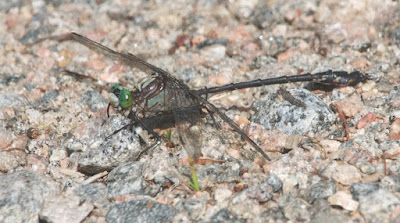





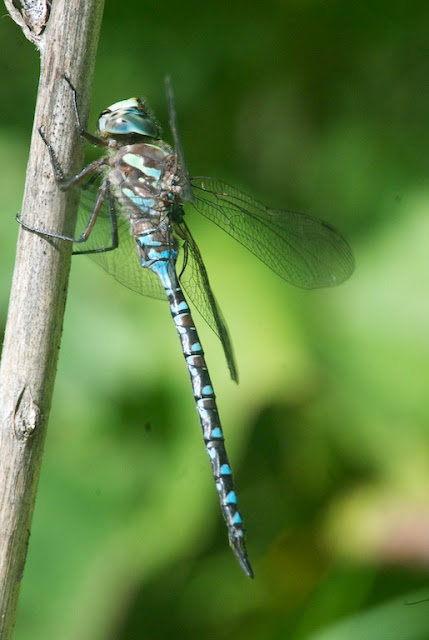
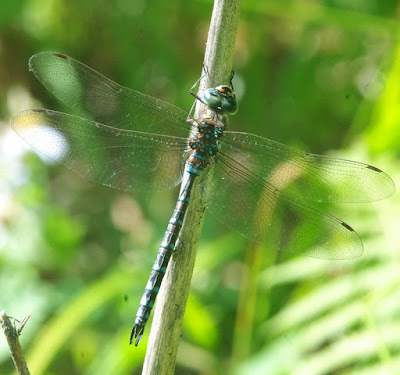


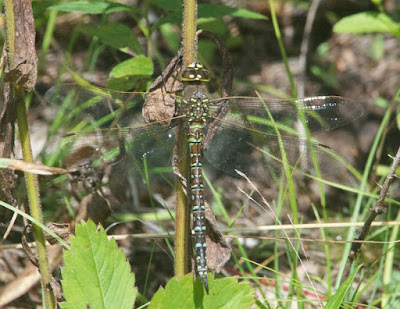

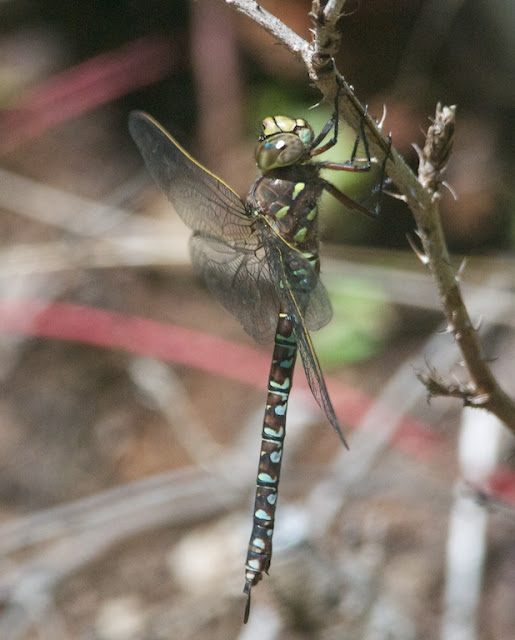


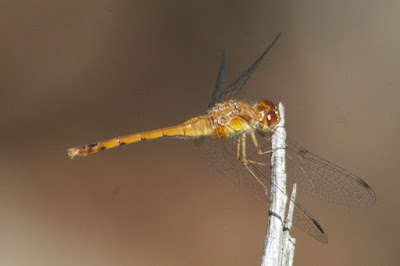





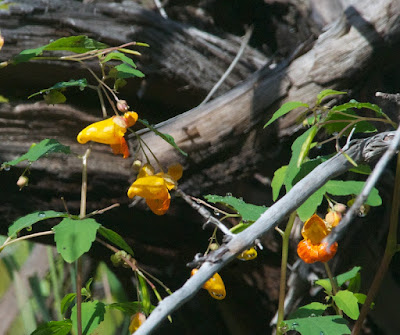

















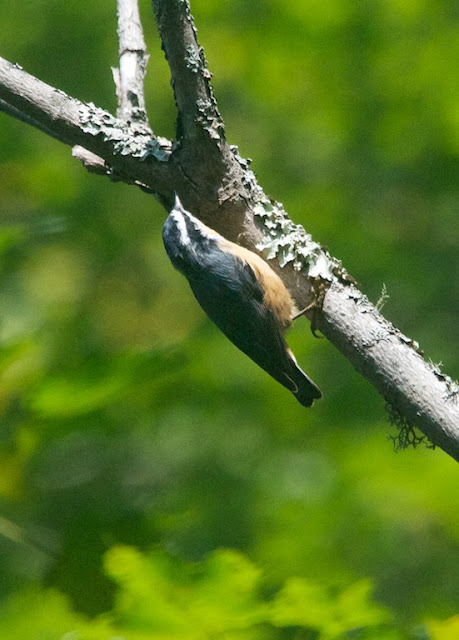








No comments:
Post a Comment